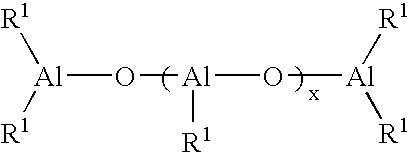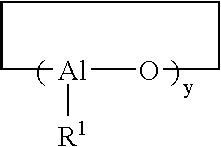Method for producing functionalized cis-1,4-polydienes having high cis-1,4-linkage content and high functionality
a technology of functionalized polymer and cis-1,4-polydienes, which is applied in the direction of wheels, tire parts, vehicle components, etc., can solve the problems of limiting the ability to functionalize the resulting polymer, unable to obtain anionic polymerization methods, and difficult to prepare highly functionalized polymers under ordinary conditions by using coordination catalysts. , to achieve the effect of high cis-1,4-linkage content and high functionality
- Summary
- Abstract
- Description
- Claims
- Application Information
AI Technical Summary
Benefits of technology
Problems solved by technology
Method used
Image
Examples
example 1
[0091]In this experiment, a functionalized cis-1,4-polybutadiene was prepared by polymerizing 1,3-butadiene monomer in bulk with a catalyst system comprising neodymium versatate (hereinafter NdV), methylaluminoxane (hereinafter MAO), diisobutylaluminum hydride (hereinafter DIBAH), and diethylaluminum chloride (hereinafter DEAC), followed by treating the resultant reactive polymer with 4,4′-bis(diethylamino)benzophenone (hereinafter DEAB).
[0092]The polymerization reactor was a one-gallon stainless-steel reactor equipped with a mechanical agitator (shaft and blades) capable of mixing high viscosity polymer cement. The top of the reactor was connected to a reflux condenser system for conveying, condensing, and recycling the 1,3-butadiene vapor developed inside the reactor throughout the duration of the polymerization. The reactor was also equipped with a cooling jacket containing cold water. The heat of polymerization was dissipated partly by internal cooling through the use of the ref...
example 2
[0094]In Example 2, a DEAB-functionalized cis-1,4-polybutadiene was prepared by polymerizing 1,3-butadiene monomer in bulk with the same procedure and the same catalyst system as used in Example 1 except that DEAB was added after 1.5 minutes from the commencement of the polymerization. The yield of the polymer was 111.6 g. The properties of the resulting polymer are summarized in Table I.
example 3
Comparative Example
[0095]In this experiment, a DEAB-functionalized cis-1,4-polybutadiene was prepared by polymerizing 1,3-butadiene monomer in bulk with a catalyst system comprising neodymium versatate (NdV), triisobutylaluminum (TIBA), and diethylaluminum chloride (DEAC), followed by treating the resultant reactive polymer with DEAB.
[0096]The same reactor and the same reactor preparation procedure as used in Example 1 were employed. After 1302 g of 1,3-butadiene monomer was charged into the reactor and the monomer was thermostated at 13° C., 29.1 mL of 0.68 M TIBA in hexane was charged into the reactor, followed by the addition of 4.58 mL of 0.054 M NdV. After the mixture inside the reactor was aged for 15 minutes, the polymerization was initiated by charging 5.30 mL of 0.14 M DEAC in hexane into the reactor. After 76 minutes from the commencement of the polymerization, 10.1 mL of 1.22 M DEAB in toluene was added to the polymerization mixture and stirred for 8 minute. The polymeriz...
PUM
| Property | Measurement | Unit |
|---|---|---|
| molecular weight distribution | aaaaa | aaaaa |
| molecular weight distribution | aaaaa | aaaaa |
| molecular weight distribution | aaaaa | aaaaa |
Abstract
Description
Claims
Application Information
 Login to View More
Login to View More - R&D
- Intellectual Property
- Life Sciences
- Materials
- Tech Scout
- Unparalleled Data Quality
- Higher Quality Content
- 60% Fewer Hallucinations
Browse by: Latest US Patents, China's latest patents, Technical Efficacy Thesaurus, Application Domain, Technology Topic, Popular Technical Reports.
© 2025 PatSnap. All rights reserved.Legal|Privacy policy|Modern Slavery Act Transparency Statement|Sitemap|About US| Contact US: help@patsnap.com


